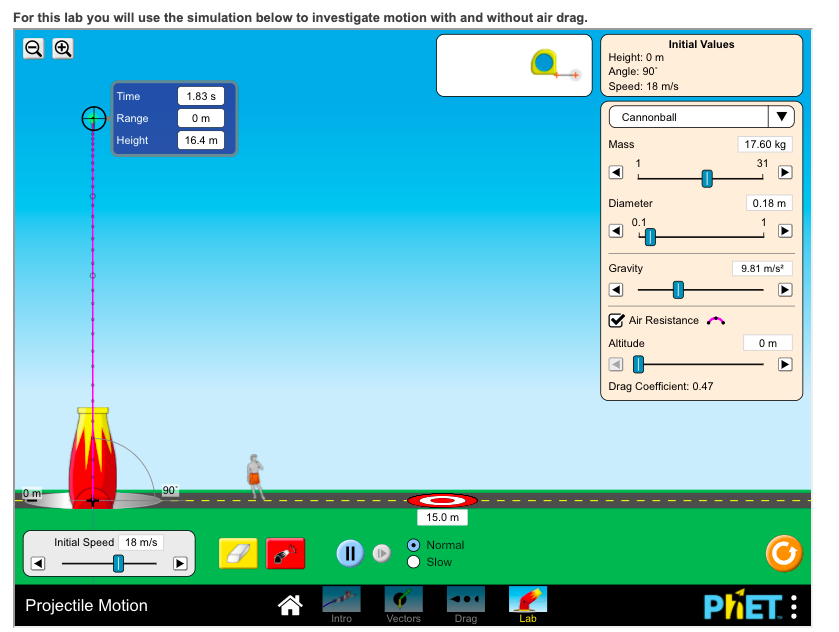3. Under everyday conditions, air drag is proportional to v². Specifically, Fa = Dv² (where D is a constant that depends on air density, the cross-sectional area, and the object's shape). Thus, the faster an object is going the greater the air drag. When an object is falling straight down, there is a speed at which the net force on the object will be zero. This speed is known as TERMINAL VELOCITY. Apply the formula you derived for Fnet to the situation where an object has reached terminal velocity (Fnet = 0) to solve for D. Let v = v7 (terminal velocity) and express your answer in terms of m, g, & vr. D= 0.03028
3. Under everyday conditions, air drag is proportional to v². Specifically, Fa = Dv² (where D is a constant that depends on air density, the cross-sectional area, and the object's shape). Thus, the faster an object is going the greater the air drag. When an object is falling straight down, there is a speed at which the net force on the object will be zero. This speed is known as TERMINAL VELOCITY. Apply the formula you derived for Fnet to the situation where an object has reached terminal velocity (Fnet = 0) to solve for D. Let v = v7 (terminal velocity) and express your answer in terms of m, g, & vr. D= 0.03028
College Physics
1st Edition
ISBN:9781938168000
Author:Paul Peter Urone, Roger Hinrichs
Publisher:Paul Peter Urone, Roger Hinrichs
Chapter4: Dynamics: Force And Newton's Laws Of Motion
Section: Chapter Questions
Problem 11CQ: (a) Give an example of different net external forces acting on the same system to produce different...
Related questions
Question
Hello, I have a question about how to calculate for D. I keep getting decimals I dont understand it.

Transcribed Image Text:2. Come up with an expression for the net force for the situation described above (ball released from rest). Enter the expression in terms of the forces by
using the symbols listed above. Let down be positive.
F
Fnet =
G
3. Under everyday conditions, air drag is proportional to v?. Specifically, F = Dv2 (where D is a constant that depends on air density, the cross-sectional
area, and the object's shape). Thus, the faster an object is going the greater the air drag. When an object is falling straight down, there is a speed at
which the net force on the object will be zero. This speed is known as TERMINAL VELOCITY. Apply the formula you derived for Fnet to the situation
where an object has reached terminal velocity (Fnet = 0) to solve for D. Let v = vT (terminal velocity) and express your answer in terms of m, g, & vT.
D = 0.03028

Transcribed Image Text:For this lab you will use the simulation below to investigate motion with and without air drag.
Initial Values
Height: 0 m
Angle: 90
Speed: 18 m/s
Time
1.83 s
Range
Om
Cannonball
Height
16.4 m
Mass
17.60 kg
31
Diameter
0.18 m
0.1
Gravity
9.81 m/s
M Air Resistance
Altitude
0m
Drag Coefficient: 0.47
0 m
90
15.0 m
Initial Speed 18 m/s
Normal
II O
Slow
Projectile Motion
PHET:
Intro
Vectors
Drag
Lab
Expert Solution
This question has been solved!
Explore an expertly crafted, step-by-step solution for a thorough understanding of key concepts.
This is a popular solution!
Trending now
This is a popular solution!
Step by step
Solved in 2 steps

Recommended textbooks for you

College Physics
Physics
ISBN:
9781938168000
Author:
Paul Peter Urone, Roger Hinrichs
Publisher:
OpenStax College


Glencoe Physics: Principles and Problems, Student…
Physics
ISBN:
9780078807213
Author:
Paul W. Zitzewitz
Publisher:
Glencoe/McGraw-Hill

College Physics
Physics
ISBN:
9781938168000
Author:
Paul Peter Urone, Roger Hinrichs
Publisher:
OpenStax College


Glencoe Physics: Principles and Problems, Student…
Physics
ISBN:
9780078807213
Author:
Paul W. Zitzewitz
Publisher:
Glencoe/McGraw-Hill

Physics for Scientists and Engineers: Foundations…
Physics
ISBN:
9781133939146
Author:
Katz, Debora M.
Publisher:
Cengage Learning

Physics for Scientists and Engineers with Modern …
Physics
ISBN:
9781337553292
Author:
Raymond A. Serway, John W. Jewett
Publisher:
Cengage Learning

Physics for Scientists and Engineers
Physics
ISBN:
9781337553278
Author:
Raymond A. Serway, John W. Jewett
Publisher:
Cengage Learning